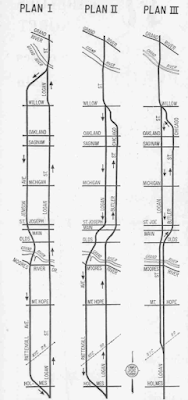MLK Blvd: From Neighborhood to Street
It might be hard to imagine now, but Martin Luther King Jr Blvd used to be a regular neighborhood street, lined with single family homes, apartments, and storefronts. Now, downtown, it is a city highway that spans almost a full city block in certain areas with its six to eight lanes and a wide median for grass and trees.
For a long time in Lansing history, Martin Luther King Jr Blvd was named Logan Street. Like many downtown city streets, it had houses, flats, mixed use, and shops along its length. And like many cities in North America, there was a movement to extend highways through their downtowns in the mid-1900s. The State Highway Department (which would become today's Department of Transportation) proposed and successfully enacted widening of Logan, part of M-99, several times since the 1960s. In 1961, the city and the state were weighing three proposals to route car traffic through Lansing. Here's a diagram from the Lansing State Journal, in 1961.
The plans were contentious, and some people in the city of Lansing voiced concerns and opposition. There are letters to the editor in the LSJ going years back from people in Pattengill and the West Side neighborhood asking the state not to bulldoze their neighbors' homes. (Lansingography has discussed other neighborhoods being demolished to build highways, I-496 is another)
Eventually, a variation on Plan 3 above went forward. Logan had been widened several times over the years already. In the 1980s, the Logan Corridor was wrapped into the Capitol Loop project, and in 1988, MDOT began interviews with homeowners for appraisal, purchase, and relocation services. An early estimate of 60 homes would need to be demolished (the number was closer to 150 homes and 300 total buildings). In 1989, the LSJ reported that MDOT would start construction in the summer of 1991, which they did.
According to Lansing City Council minutes, 1989 was the same year that Logan was "codesignated" as MLK. In 1994, the signs saying Logan were officially dropped and Martin Luther King Jr Boulevard served as a throughfare through our city.
Bye, Bye, Busy Bee Market
The local homes and businesses were closed, and some were relocated. A doctor's office, the Busy Bee Market, Calhoun's Takeout, Hazel's Salon, and Frank's Grocery store all closed, to be replaced with a street for people to drive through Lansing.
There are letters to the editor in the LSJ from residents of the West side neighborhood who were concerned about being disconnected from the rest of Lansing and from the amenities downtown. In addition to the commercial areas on Logan and Butler being demolished, there was a raised crosswalk over Logan that was being taken down. Pedestrians would now need to cross the street at car level.




No comments:
Post a Comment